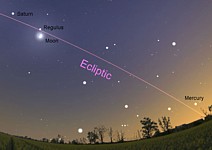8) Based on the movement of these points against the starry background, it will be possible to predict their position at a future time.
 When it has been determined that planets move relative to the background of "fixed" stars, a first distinguishable factor is that the rate of displacement is not the same for all. Some can travel more space in less time than others, and this allows for the assignment of "predictions" as to the time that must pass for a planet to position itself in a certain sector of space. If the monitoring includes witnessing retrograde movements, it is even possible to determine future retrograde movements, through mathematical calculations that diagram the position of the planet in relation to the Earth. If to this is added a discrimination of the changes in brightness, it is possible (although to a lesser degree) to make a speculation about the distance at which the object may be located (of course without measure the distance itself, just speculating if the object is further away or closer). These positional predictions, as they become more complex, exponentially increase the required tracking time.
When it has been determined that planets move relative to the background of "fixed" stars, a first distinguishable factor is that the rate of displacement is not the same for all. Some can travel more space in less time than others, and this allows for the assignment of "predictions" as to the time that must pass for a planet to position itself in a certain sector of space. If the monitoring includes witnessing retrograde movements, it is even possible to determine future retrograde movements, through mathematical calculations that diagram the position of the planet in relation to the Earth. If to this is added a discrimination of the changes in brightness, it is possible (although to a lesser degree) to make a speculation about the distance at which the object may be located (of course without measure the distance itself, just speculating if the object is further away or closer). These positional predictions, as they become more complex, exponentially increase the required tracking time.
Preliminary conclusion: Orbital determination of the planets. This conclusion remains independent, so far, of a hypothetical observer who considers the Universe geocentric. However, the crucial factor is to witness the retrograde motions, which only occur in outer planets. Since this is a problem for a geocentric model, a follow-up of several years would eventually result in a model where the Earth is also orbiting, and where the only reason for some planets to "recede" at certain intervals is because the Earth is "overtaking" them in its orbit.
9) That these points also move along the same "band" as the Moon, the Sun and certain regions of stars.
 With this exercise, the importance of that imaginary line in the sky, the ecliptic, is finally defined, since it not only delimits the path that the Sun follows in the sky, but also the Moon, some constellations that the observer has invented along the way. over time, and also of the now identified planets, which persistently move through this sector of space, which now gives strong indications that all these objects are associated with each other, and are subject to some type of ordered movement that can be diagrammed , in some way, in a mathematical system capable of predicting its position at any moment.
With this exercise, the importance of that imaginary line in the sky, the ecliptic, is finally defined, since it not only delimits the path that the Sun follows in the sky, but also the Moon, some constellations that the observer has invented along the way. over time, and also of the now identified planets, which persistently move through this sector of space, which now gives strong indications that all these objects are associated with each other, and are subject to some type of ordered movement that can be diagrammed , in some way, in a mathematical system capable of predicting its position at any moment.
Preliminary conclusion: Final significance of the ecliptic lineAlthough the ecliptic is nothing more than an imaginary line, sustained observation of the stars that move independently of the "fixed" stars provides concrete information about the movements that occur around the Earth. Although these observations are not sufficient to cast doubt on a geocentric system (except for the retrograde motion of the outer planets), they do allow the environment outside the Earth to be ordered and formalized in a deterministic and predictable way.

